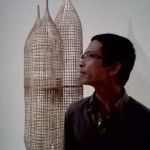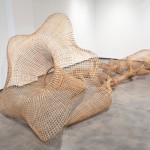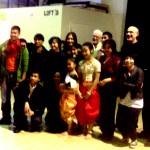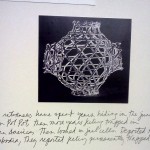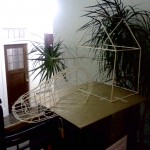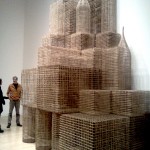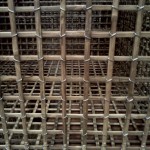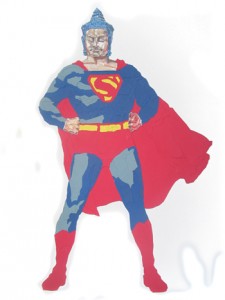Sopheap Pich “Compound”
Sopheap Pich’s installation Compound at the Henry Art Gallery in Seattle is an oasis of peaceful structures that can evoke anything from bombs ( according to the artist) to fish traps, chicken coops, cages, high rises or fantasy playscapes (I thought of children crawling underneath and through these light weight structures.)
There is a lot of information about the Sopheap Pich on the website of Tyler Rollins because Sopheap is having a simultaneous one person show there. It features Morning Glory made of the same rattan and wire as Compound. Morning Glories for the artist refer to a survival food in Cambodia during his childhood, when the Khmer Rouge controlled Cambodia.
He escaped with his family to a refugee camp in 1979 and then to Massachusetts in 1984. The story of the escape of many refugees with experiences in common with him is the subject of an astonishing play by Mark Jenkins, Red Earth Gold Gate Shadow Sky. The play is directed by Victor Pappas with all the actors Asian Americans, most of them Cambodian born and many who endured similar traumas as those presented in the play. There will be more performances next weekend at High Point Community Center in South Seattle.
The play is a reading and pantomine that includes Cambodian singing ( by a pop star in Cambodia) and Cambodian dancing ( by two young people), as a play within a play, performed at a refugee camp. The play begins with the American bombing of Cambodia (remember that in the winter of 1970) and it follows the disruption of one agricultural family to the city, back to the country side, taken by the Khmer Rouge in 1974, forced to produce food they could not eat for the Khmer Rouge, escape into the jungle, bare survival, escape to refugee camp in Thailand, several years of terrible treatment, sponsorship to US, placed in ghettoes here, gangs, difficulties ( Part II will treat the forced return of some of these people as a result of the new immigration laws, there is a photographic exhibition about some of them after they return to Cambodia that is devastating). The period has been presented in the 1984 film by Dith Pran, The Killing Fields and there are also books with memories of other survivors. This production is a collaboration with Don Fels, Seattle based visual artist, Sopheap Pich who has created “visual framing” for the project, and others.
Sopheap had many of these same experiences: like so many other Cambodians he went through repeated traumas. In 2003 he returned voluntarily to Cambodia. He found his current medium, the material that comes from his childhood as the son of rice farmers, the traps of fishing and of other agricultural implements.
It is a cheap material, he harvests the wood himself. His sculptures are made from the trees, split , boiled and shaped, the wood is made into a mesh with fishing wire meticulously wound at hundreds of intersections – the wire made from metal recycled from left over war materials that were carted to Vietnam and then brought back as resusable materials. This detritus of war was the foundation of construction material until recently.
But now Cambodia is having a huge and ecologically destructive development surge, particularly around the capitol. Sopheap’s studio was on a lake, a cabin on stilts. The entire lake is being destroyed for development, shown in a few photographs that accompany the sculpture.
“Compound” can be a prison or a fantasy city. It is built out of the cheapest material, it can be an allegory of the new Cambodian economy, the new cities being built as most Cambodians still live on a dollar a day. They are a compound and an imprisonment, as well as a dream and a fantasy. They invite you to enter but prevent you from doing so.
Sopheap has rearranged the bomb like shapes to be towers of this city, in previous installations they rested underneath the city. Bombs into towers, war into development, but development built on air with the work of the peasant. These simple structures suggest all of this, even as the artist has declared that they are abstract. He spoke of creating a peaceful environment in his studio, an oasis of calm with his team of workers as they build the rattan with its intersections connected by wire.
Calm and peace. Coming out of the traumas of his past. It makes a lot of sense. In his previous work ( see the website above for his other work) he created organs, body parts out of rattan, he made reference to the war traumas more directly in his statements. Now he has moved to a less specific expresssion, and he specifically stated that he was not a political artist, no doubt coached by the international art scene that being “political” is not an accepatable concept. But abstract, allegorical, metaphorical though his work is, it is deeply political as well.
Peace is a political concept.
As part of the events in Seattle, Boreth Ly, a brilliant Cambodian academic based in Santa Cruz, discussed Sopheap’s work as well as that of other contemporary Cambodian artists, You Khin, Chakra Oeur, Sarith Peou, Aragna Ker and Seckon Leang with the theme of the trauma of memory and displacement, “home” and identity. Unfortuantely the nightmares of the past are still visited on the present, not only in their dreams, but also in present day Cambodia which is being destroyed by development. Cambodian American Aragna Ker’s image of a Superman Zarathustra provides one way forward!
This entry was posted on November 12, 2011 and is filed under Sopheap Pich.

